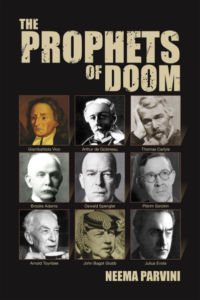Neema Parvini’s Prophets of Doom: Cyclical History as Alternative to Liberal Progressivism
The following is reprinted from the Imperium Press Substack.
Neema Parvini
The Prophets of Doom
Societias, 2023
In polite circles today, you have two choices: You are either a progressive, or a complete reprobate. This is because “progress” is one of our foundational myths. You’re allowed to question the American Revolution or the Norman Conquest; you’re even allowed to question your own biology. But you’re not allowed to question the myth of progress; questioning it is like questioning freedom: If you’re not for freedom, you must be for the opposite of freedom — which is, we’re told, slavery.
What is the opposite of progress today? Stagnation at best, maybe decline. This is the dominant framing among the upper class, and has been for centuries. But ever since the myth of progress was born, there has been a counter-current pushing back against it. Sometimes this current simply stands progress on its head, and speaks of a long fall from some idealized state. This is not much of an alternative; it’s just the mirror image of progress. But sometimes this current takes the form of cyclical history, a true alternative to linear history, whether optimist or pessimist. At all times, cyclical history has been with us.
Neema Parvini has written a new book, The Prophets of Doom,[1] that tracks this lineage of cyclical historians from the early modern era to the present day. Parvini is the author of The Populist Delusion, and has conceived this book as the next installment in the series. Imperium Press released The Populist Delusion, and so I am hardly a neutral observer here, but this newest book of his is perhaps even more important. Let us explain why before moving on to the content of the book.
The myth of progress underpins many other foundational myths, including that of the American Civil War and the Second World War. Whereas Populist Delusion explains how reality functions, Prophets of Doom does that and something else. Prophets, as exposition of cyclical history, is mythic in the Sorelian sense: It locates us in a narrative, in a trajectory. It tells us not only what, but whither. This is why history is always master over philosophy, poetry over science. And Prophets does this not simply through the mouths of its historians, but also by recasting the intellectual history of the West to include this dissident strain. By foregrounding giants such as Vico, Carlyle, and Spengler, it says “that’s just not who we are” — rhetoric previously left to the Tony Blairs of the world.
The book begins with Tony Blair, avatar of “progress,” telling us that his personal vision is inevitable and that we might as well join the winning team. Parvini wants to call this into question, and to “identify what, if anything, can challenge the dominant progressive paradigm and the complacent received ‘wisdom’ of our epoch.”[2] What we find is shocking. Far from Blair’s vision being inevitable, as it turns out:
We live in the aberration. The End of History did not materialise and will one day be regarded as a self-contained epoch that started in the direct aftermath of 1945 and will end at some point in the future, during which some great things were achieved and during which most educated people took leave of their senses.[3]
Only a few pages in and we have already blasphemed. But before we continue further into the Hadean underworld, a few clarifications are in order. Parvini sets the parameters of his investigation, focusing on modern thinkers, but first he deals with the ancient exponents of cyclical history. Some are genuinely cyclical, such as Polybius and Ibn Khaldun (who will make a ricorsi in the penultimate chapter). Some, however, are less so, such as Hesiod and Zoroaster, both of whom we have dealt with elsewhere. While both have proven influential on the prophets of doom, they are really more our aforementioned “inverted” linear historians. Still, Parvini is right to address them to the reader, as they will come back in some form or another throughout the history of ideas.
Our first prophet is Giambattista Vico, who lays down the model for what is to come, and lays arguable claim to the title of greatest of all the prophets. Vico pre-dates the Enlightenment proper, but already we see a radical departure from the ideas that were “in the air” about the time of the Scientific Revolution. Vico’s model sets out to reject Cartesian rationalism, and it does so by emphasizing man’s historically conditioned nature, what Heidegger will call his thrownness. Vico rejects the abstracting of man away from his background, he is a thinker of this world, and underscores man’s contingency within it. But Vico is no mere reactionary: In recognizing man’s essential embeddedness, he anticipates in very concrete ways what post-structuralists such as Deleuze, Derrida, and Foucault will come to rediscover later in their own attempts to shake off Enlightenment baggage.
The Vichian model is a succession of ages: that of Gods, Heroes, and Men. We begin in the Age of Gods, where barbarians explode out of the hinterlands, spurred on by pre-reflective vitality and a “dream-heavy” view of the world as populated by higher intelligences, not all of them friendly. This gives way to the Age of Heroes, a time of military virtue, pragmatic genius, and rigorous formalism. This develops naturally into the Age of Men, where the fruits of the earlier vitalism and genius must be managed reflectively with reason. This creates a shiftless life of ease in which the society has the luxury of questioning the commands and beliefs inherited from the earliest times, leading to total disenchantment. At this point we get something that will sound familiar to readers:
Without those beliefs, society will experience ‘the slow distinction of unreasoned family attachments’ and a breakdown in order on the basis that ‘if each person his is own master then each person is also his own judge.’ This is how, in the current year, adults expect their children to be able to decide their own gender. ‘Individual freedom and philosophy are . . . equally dangerous in Vico’s eyes because they imply each other: once freed from ignorance and injustice, man will almost naturally seek to free himself from authority, religion, and tradition — the very foundations of social life.’[4]
We then enter into what Vico calls the “barbarism of reflection,” where hyper-individualism and the reign of individual conscience breaks down all social constraint, men rut like animals and stab each other in the back while seeing themselves as moral exemplars. With nothing to discipline them but themselves, men eventually destroy their own society, and we enter into a renewed barbarism that restarts the whole cycle again.

You can buy Georges Sorel’s Reflections on Violence from Imperium Press here.
Vico sets the model for what is to come, but the next prophet is different in tone and in some ways in content to him. Thomas Carlyle agrees with Vico that the modernity of his time is debased, and that it is the poetic or pre-rational that forms the basic “glue” that holds society together. He also agrees that progress is a mere myth, that the great man will come like a cleansing fire to purify a decadent and dying world. However, Carlyle was himself a far more poetic writer than Vico, and much less systematic. Whereas Vico’s model is quite distinct, Carlyle has no real chronology, but is content to observe the periodic shift between rationalistic and poetic ages. Carlyle is also notably pessimistic in tone, perhaps the most of any of our prophets.
Arthur de Gobineau comes next and puts his own spin on the cyclical model. Frequently cited as a pure biological racialist, Parvini very helpfully substitutes the poetical descriptions primal, chivalric, and practical for Gobineau’s respective black, white, and yellow categories. Gobineau emerges as a much more nuanced thinker for it, and the reader comes away with a better understanding of him. Controversially, for Gobineau, “race” is everything and religion is almost a non-factor; we could say that race is coextensive with religion, something very familiar to folkish thinkers.[5] He gives us a picture where each of the three races are pushed together by mutual dependency, which sows the seeds of destruction in their mongrelization. While Gobineau’s model, properly understood as a set of biological tendencies rather than actual races, comes to resemble Vico, he sees no regeneration on the horizon — a true doomsayer.
In all three thinkers thus far, some broad outlines emerge: the “poetic” vs. the “rational,” age, disdain for merchants, a cultural relativism, an “irrationalism,” an affinity for the medieval/poetic/Gothic period, religion as superficial or the expression of a folk-soul, etc. But Brooks Adams is the first in the lineage to really and truly approximate Vico. He follows the “irrationalist” model of positing the pre-reflective mode of thought as foundational, beginning with an Age of Fear, continuing on to an Age of Greed, and on to a new sort of barbarism. However, Adams was a true prophet of doom in that he believed that “there would be no regeneration for the West and that the cycle will be effectively over once America and Europe collapse.”[6]
Next is Oswald Spengler, who is well known in our sphere for his poetical approach and organic metaphors. He emerges as perhaps the most formidable, unique, and interesting of the prophets, as well he should. After him are two much less familiar to us, Pitirim Sorokin and Arnold Toynbee. Sorokin is the first of our prophets to really have a claim to scientific status and to use a more empirical approach with statistical analysis. But the story is roughly the same: Societies move from the ideational phase of immaterial spirituality to the sensate phase of pure empiricism, adding a third happy medium called the idealistic. Sorokin strikes the folkish reader as a bit off the mark with his insistence on immateriality and abstraction as the root of spirituality rather than a sign of decadence, and as one of the less interesting thinkers.
Toynbee also seems a bit off the mark, though perhaps more formidable in some ways, not least for devoting three million words to his Study of History. Somewhere between Vico and Spengler, Toynbee distinguishes himself with his challenge and response model where a society must respond to the challenges of material, internal, or external factors (such as other civilizations), which produces either high cultures or societies that are arrested, aborted, or fossilized. The high culture follows the familiar model of growth and decay, culminating in a “universal church” which can then sire daughter civilizations. This runs into trouble in non-Abrahamic civilizations and is quite clearly a Procrustean move; Toynbee is always trying to get out from under the weight of Spengler and his more rigorous cultural relativism.

You can buy Julius Evola’s East & West here.
We then come to Julius Evola, well known in our circles for his mysticism and esotericism. Parvini’s treatment of him is excellent and objective, and Evola comes off as somewhat at odds with himself, where his universal, capital-T “Tradition” “cannot ever fully reconcile itself with his view, for example, that Western man cannot ever fully embrace a Brahmin or priestly ruling caste, or his ‘spiritual’ theory of race which is partly derived from Gobineau.”[7] However, Evola’s far-sighted view of America as an enemy of Traditionalism equal to the Soviet Union is prescient, especially in the 1950s.
The last three of the prophets are less known to most outside of specialist circles, though for this reason perhaps the most worthy of inclusion in the book. John Bagot Glubb is the only prophet belonging to the warrior caste, and uses his deep knowledge of the Islamic world to come up with a cyclical history very much on the model of Vico, Adams, and the rest. Joseph Tainter and Peter Turchin recall Sorokin’s empirical and “scientific” approach, and with their emphasis on material factors and quantitative analysis, form a useful foil to the more qualitative, narrative approaches of the other thinkers. Still, Tainter comes in for an especially savage critique, and Parvini with his libertarian roots is quite well-equipped to both elucidate and critique him. The ultimate impression of these last two is as useful ministers to Spengler, Vico, etc., but not their masters.
There are three interrelated concepts running throughout the book: a) pessimism or doomsaying, b) inverted progress, and c) cyclical history. The three are not entirely commensurable; the relation between them is complex and at times sketched out in the book quite clearly; at other times, less clearly. One would like to have had more discussion on this and perhaps a clearer delineation. However, the prophets themselves occasionally mixed elements of both linear, Hesiodic history, and cyclicity in novel ways, such as in Evola, so one can only ask so much in an introductory work.
The Prophets of Doom is important for our milieu and a useful point of departure in shedding progressive mythology. Surveys such as this and Parvini’s Populist Delusion serve an important purpose: If the prophets are right, we are entering into a historical epoch where practical men of action will come to dominate world affairs, and Parvini’s book, via the prophets, can provide a kind of charter for Carlyle’s great man to recognize himself as properly sovereign. He is not simply a man sprung fully formed from nothing, but born of a lineage including the greatest thinkers of modern times; as Parvini says, it is the progressive who is the aberration. This places us in a historical arc very different from what the Tony Blairs of the world would have: They know the great man is coming, and this is why they shriek so hysterically when anyone points this out to them.
* * *
Like all journals of dissident ideas, Counter-Currents depends on the support of readers like you. Help us compete with the censors of the Left and the violent accelerationists of the Right with a donation today. (The easiest way to help is with an e-check donation. All you need is your checkbook.)
For other ways to donate, click here.
Notes
[1] Neema Parvini, The Prophets of Doom (Societas, 2023).
[2] Ibid., 5.
[3] Ibid., 6.
[4] Ibid., 33–34.
[5] He says, “Christianity will certainly do its best to bring such an improvement about; but it will not try to alter a single custom . . .” Christianity, being propositional, cannot issue commands in any fundamental sense because the command is upstream of the proposition.
[6] Prophets, 65.
[7] Ibid., 139.




